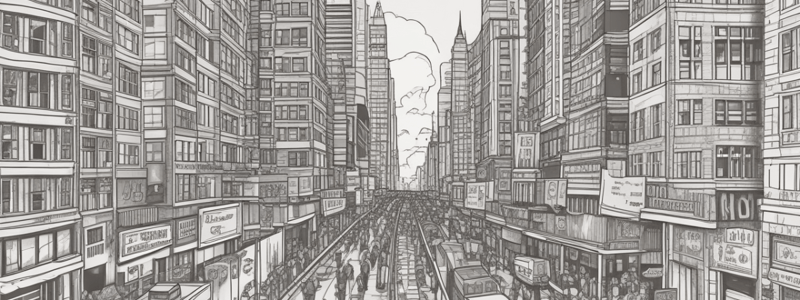Podcast
Questions and Answers
What shift has the U.S. economy experienced over the past two decades?
What shift has the U.S. economy experienced over the past two decades?
- From a technology economy toward a financial services economy
- From a service-producing economy toward a manufacturing economy
- From a manufacturing economy toward a service-producing economy (correct)
- From a financial services economy toward a manufacturing economy
Which industries have seen a rise in job opportunities as manufacturing jobs have decreased?
Which industries have seen a rise in job opportunities as manufacturing jobs have decreased?
- Agriculture and retail services
- Construction and hospitality
- Technology and financial services (correct)
- Transportation and education
How is information on the labor force collected in the U.S.?
How is information on the labor force collected in the U.S.?
- By monthly household surveys from the Department of Labor (correct)
- Via annual employment reports
- Through semi-annual census data
- Through weekly phone calls
What criteria do economists use to consider someone employed?
What criteria do economists use to consider someone employed?
What happens to individuals with more than one job according to the text?
What happens to individuals with more than one job according to the text?
What percentage of the US population was part of the labor force in 2013?
What percentage of the US population was part of the labor force in 2013?
As of the data provided, how many million people were employed in the United States in 2013?
As of the data provided, how many million people were employed in the United States in 2013?
Which group is not considered in the labor force according to the text?
Which group is not considered in the labor force according to the text?
What is required for a person to be counted as unemployed?
What is required for a person to be counted as unemployed?
In July 2007, what was the highest unemployment rate reported?
In July 2007, what was the highest unemployment rate reported?
What is one of the key factors contributing to the increase in the service sector in the United States?
What is one of the key factors contributing to the increase in the service sector in the United States?
Between which decades did the largest drop occur in the number of employees in goods-producing industries?
Between which decades did the largest drop occur in the number of employees in goods-producing industries?
What has been the general trend for the number of employees in goods-producing industries since 1947?
What has been the general trend for the number of employees in goods-producing industries since 1947?
How many more workers produced services compared to goods in 2005?
How many more workers produced services compared to goods in 2005?
Flashcards are hidden until you start studying
Study Notes
The Labor Market Today
- The Bureau of Labor Statistics provides answers to two important economic questions: the size of the labor force and the number of employed and unemployed individuals.
- The percentage of the US population in the labor force has increased from 59.2% in 1950 to 63.2% in 2013.
- In 2013, the number of employed civilians in the United States was close to 144 million.
Composition of US Labor Force
- The labor force consists of 153.9 million individuals, with 139.1 million employed, 14.8 million unemployed, 1.4 million active military, and 5.8 million institutionalized.
- 89.7 million individuals are not counted in the labor force, with 82.5 million considered "other".
Occupational Trends
- The job market grows and changes with the nation's economy and population.
- The unemployment rate is calculated by considering individuals who are temporarily without work or are not working but have looked for jobs within the last four weeks.
- Students, parents who stay at home to raise children, and retirees are not considered unemployed and are not counted in employment statistics.
- The unemployment rate in July 2007 was the highest, at 4.6%.
- The average unemployment rate from 1970 to 2007 was 6.3%.
- In 2008, the unemployment rate increased significantly.
Shift from Manufacturing to Service Economy
- The American economy has transitioned from a manufacturing economy to a service economy, with the production of services increasing faster than the production of goods.
Service Sector
- The service sector includes financial services, banking, education, and online services.
- In 2005, five workers produced services for every one who produced goods.
Decline of Manufacturing Jobs
- The United States has experienced a decline in manufacturing jobs, with 17.7 million Americans working in manufacturing industries in 1990, decreasing to 14.2 million 15 years later.
- Many workers have been laid off due to plant closings.
Change in Industry Since 1947
Employment Trends
- The number of employees in goods-producing industries has been declining since 1947, from 100 million in 1947 to 20 million in 2007.
- The number of employees in service-producing industries has been increasing, from 40 million in 1947 to 100 million in 2007.
Studying That Suits You
Use AI to generate personalized quizzes and flashcards to suit your learning preferences.



